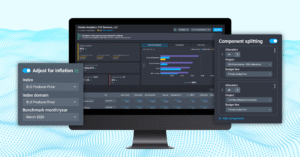The COVID-19 pandemic shifted the way people work, live, and interact with urban spaces, leading to a rise in remote or hybrid work and a dramatic decline in demand for office space. Even though many workers have returned to in-person work in some capacity, the enduring popularity of remote work has reshaped the office market for the long term. Developers looking to revitalize outdated or poorly located offices should consider office-to-residential conversions, especially as state and local governments continue to incentivize these projects to boost housing production in 2025 and beyond.
Looking toward the future, office–to-residential projects will likely remain on the rise as high-demand markets continue to grapple with housing shortages, Office-to-residential conversions totaled 21,300 units in 2022, doubling to 45,200 in 2023, and rising again to 55,300 in 2024. Now, in 2025, office-to residential projects are expected to reach an all-time high with 77.700 offices expected to be converted. Developers looking to pursue the projects will also continue to have government and tax incentives on their side, as states continue to expand funding programs and expedite zoning or permitting processes for redevelopment projects.
Here’s everything you need to know about the current state of office-to-residential projects and where developers can continue to find opportunity:
The Driving Factors Behind Office-to-Residential Conversions
The Remote Work Revolution
Hybrid and remote work trends are the primary market forces driving office-to-residential conversions. Even as pandemic-era restrictions have eased, workers’ preference for remote work and businesses’ desire to cut costs by reducing office space have diminished demand for large corporate office space. Property owners now have an incentive to convert underutilized or vacant office space into housing, especially in major markets where office vacancies and housing shortages are both more acute.
Rising Demand for Housing
Housing shortages are a concern across the United States, and high demand markets such as New York, Los Angeles, and San Francisco are struggling to offer residents affordable housing options. Policymakers and researchers agree the urgent need for housing is being driven by a shortage in housing supply, with recent estimates suggesting the market is short 4.5 million homes. Lawmakers looking to spur housing production have doubled down on greenlighting office-to-residential conversion projects. Developers should keep an eye on state and local policy around conversion projects to take advantage of expedited permitting processes, tax incentives, or other grants.
Financial Incentives and Government Policies
Ongoing subsidies and tax incentives are continuing to drive office-to-residential conversions across the United States. Many states have successfully implemented programs to support office-to-residential projects. New York enacted a 90% property tax exemption for properties with at least 25% of units set aside for affordable housing as part of the state’s FY 2025 budget. Ohio’s Historic Preservation Tax Credit offers abatement for historic office buildings turned into apartment units. California’s InfIll Infrastructure Grant program gives competitively to office-to residential projects. Every state will have a different structure or strategy for implementing these programs, so researching available funding in your chosen market is essential.
Developers can also take advantage of other state and local programs and amended zoning or building policy to facilitate office conversions. For example, developers in Massachusetts can apply for technical assistance from the state’s Commercial Conversion Initiative. The program supports adaptive reuse projects by providing feasibility analyses and lowering regulatory barriers for qualified projects. Zoning laws across the country are also shifting to boost housing production. Florida’s Live Local Act combines tax incentives with provisions exempting affordable housing projects from planning and zoning obstacles. Similarly, Rhode Island updated zoning policy to allow for office-to-residential projects with high-density and affordable units to move forward more quickly.
Environmental and Sustainability Benefits
Developers looking to align portfolios with environmental sustainability policy can also benefit from pursuing office-to-residential conversion projects. Conversion projects, which upcycle existing structures instead of building new, are already better positioned to reduce waste and meet carbon reduction goals. Repurposing existing properties instead of demolishing them lowers construction waste and preserves resources. For properties built after 1980, retrofitting can be especially cost-effective as the building is less likely to require structural changes. Building ground-up green projects can also be more expensive than retrofitting an existing building with sustainable features.
Challenges and Considerations
Office-to-residential development projects are not without unique challenges, and your team can benefit from evaluating potential obstacles in the pre-development stage. Since office buildings are not built for residential use, structural setbacks–such as removing dividers or columns separating the space–should be the first consideration. Developers will also need to factor in costs of adding kitchens, gas lines, plumbing, or other utilities into project budgets, especially in older properties.
Zoning and building laws can also be obstacles for getting office-to-residential conversion projects off the ground. Developers need to look at the building’s zoning and use classifications, and may need to apply for a change in zoning, meet with city planners or local planning boards, and go through appropriate public hearings. Luckily, state and local governments have acknowledged these proceedings are slowing down the development process, and many are expediting permitting for developers whose projects align with the market’s housing production needs.
Notable Office-to-Residential Case Studies
Here are a few examples of office-to-residential projects that are expanding housing options in high-demand markets and positively reshaping communities:
The Tribune Tower in Chicago, IL: The Tribune Tower in Chicago, an iconic historic landmark, has been successfully converted into 950,000 square feet of residential and commercial space in the city’s Miracle Mile. While its historic facade was carefully restored and preserved, the building now features a retail frontage, a public plaza, and modern residential offerings.
Ames Center in Arlington, VA: The office-to-residential conversion of Ames Center in Arlington, Virginia is expected to revitalize the Rosslyn area by adapting two underutilized office towers. The property will include sustainable design components, such as biophilic architecture and thoughtful mixed-use programming for residents.
The Care Tower in Los Angeles, CA: The Care Tower in downtown Los Angeles, built in 1987, is slated for redevelopment into residential housing. The developers anticipate low construction costs since the building does not require significant structural changes to meet seismic building codes and utility systems are up to grade. At the same time, the tower will undergo a significant makeover, with office fixtures slated to be removed and rebuilt as apartments. Los Angeles is currently modifying building codes to expedite the permitting process for buildings constructed after 1975, which will also benefit the property.
These are only a handful of the case studies from around the U.S. that highlight the potential of office-to-residential conversion projects.
Leveraging Technology to Facilitate Adaptive Reuse Projects
Developers pursuing complex redevelopment projects can benefit from a proactive approach to the project lifecycle. Budgeting is a key component of ensuring an office-to-residential project ends up being a profitable endeavor for your firm. Modern real estate development software can help you leverage analytics and predictive insights to identify concerns before they derail your project, helping you optimize and improve your financial forecasting across the lifecycle. Northspyre can provide your team with analytics for costs, budget lines, vendors, schedules, and more, ensuring you keep costs low on complex adaptive reuse projects. You can also use Northspyre to become more competitive in the vendor procurement process, using analytics and AI bid management to give you reliable data about new vendors and reduce scope gaps or change orders.
Book a demo to learn more about how Northspyre can help you achieve predictable outcomes on your complex development projects.



